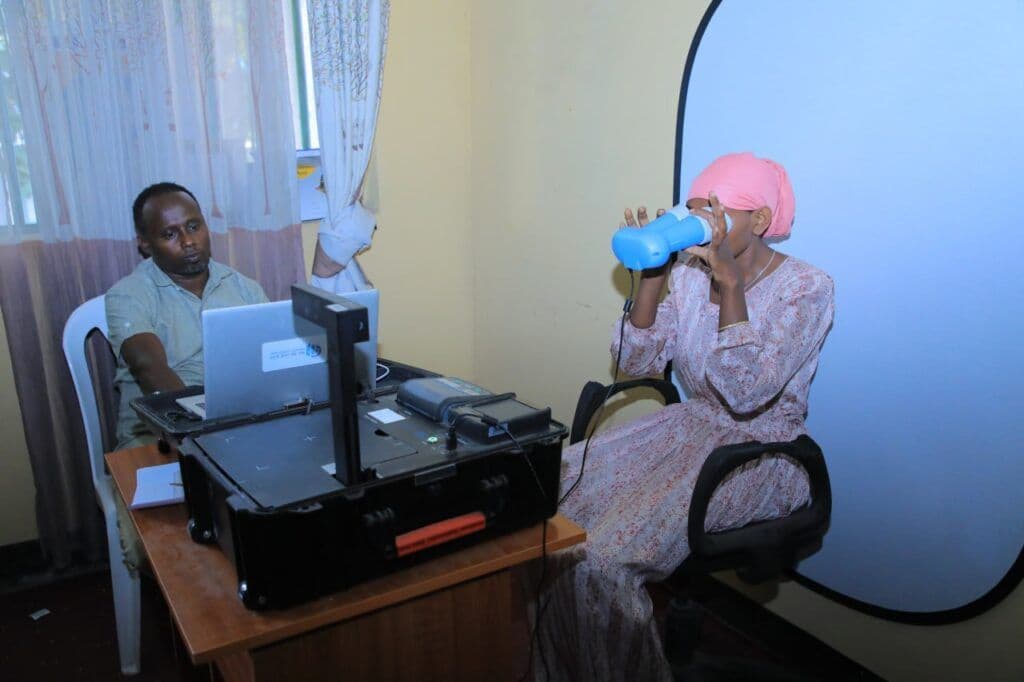Progress for 0 ad
Progress for 1 ad
Progress for 2 ad
Progress for 3 ad


Etenat Awol
Addis Ababa, Ethiopia

Zinash Sete has been eagerly awaiting an opportunity to return back to the Middle East for the past eight months. After an arduous back-and-forth process that saw her move between her hometown in Hayq, Amhara Regional State, and Addis Ababa, 430 km away, she made it to the Kingdom of Saudi Arabia last year. However, her hopes of earning decent wages for domestic work in the Gulf state faced serious setbacks within a month of her stay.
“I was not being treated properly,” she recalls.
After snaking past threats of deportation by her employer, who demanded she stay until an alleged debt was fully paid, Zinash finally reached a migrant support agency.
Albeit finding little support or relief at the agency, which was juggling meager resources and a cascade of similar demands from several other women, she faced a bleak future. A job offer at half the 1,000 Riyal monthly minimum wage for Ethiopian domestic workers and negotiations with her former employer were her only options.
“I was never the priority,” Zinash told Shega.
Yet she remained undeterred, pinning her employment prospects on some future good news from the agency. Unfortunately, all she received was a one-way ticket to Ethiopia. Zinash resisted with little effect. She informed the agency of a 50,000 birr payment to a broker back home. No one knew the broker, and Zinash would find herself on a flight back home already plotting her return.
Every year, hundreds of thousands of Ethiopian women go on a perilous journey seeking a better life as domestic workers in the Middle East. Yet, stories of abuse, withheld wages, and even physical violence are all too familiar to returnees. Illegal migration significantly contributes to the issue, with nearly half the over 700,000 Ethiopians living in Saudi Arabia having traveled through illicit means.
In early 2023, the Ethiopian government introduced a program to send half a million domestic workers to the Middle East through a comprehensive employment program. An online portal dubbed the Ethiopian Labor Market Information System (E-LMIS) is central to the scheme, which includes a job matching platform and a labor market information database.
Prospective domestic workers receive a several-week training program, Certificates of Conformance (COC), and medical checkups under the scheme.
Three months ago, the Minister of Labor & Skills (MoLS), Muferiat Kamil, revealed that nearly 512,000 workers had been sent to various countries since the program’s installment, with 92% utilizing E-LMIS. A staggering 98% of the workers were women.
Around 470,000 migrant workers primarily deployed in Qatar, Saudi Arabia, the UAE, and Jordan have used the LMIS service alongside nearly 1250 local foreign employment agencies. The Over Sea Workers feature has simplified the facilitation of binding legal contracts and allows for improved tracking of migrant domestic workers, which had been difficult before the LMIS project.
Brook Teferi, Senior Software Developer & Data Analysis Team Lead at LMIS, says the idea for the project goes back 12 years. He points to the establishment of the MOLS nearly three years ago and the consequent opening up of frameworks as necessary preconditions.
An amendment to the ‘Overseas Employment Proclamation’ that ushered increased oversight on recruitment agencies, pathways to minimum wage provisions, as well as training and increased protection for workers, are crucial regulatory strides in recent years. Bilateral agreements with destination countries like Saudi Arabia, the United Arab Emirates, and Lebanon provided additional bulwarks.
“Several countries have labor market information systems, so we started with research and identification of their use cases,” Brook told Shega.
He recalls identifying around ten key features to present to the Minister before development of the project could commence. Preliminary assessments revealed a huge market mismatch with surplus labor supply and employers struggling to find qualified talent, according to Brook.
Biometrics registration, National Job Portal, National Labor pool, National Recruitment Platform, Demand Management System, and 17 other features have been added to LMIS since its November launch last year. The services provided in five local languages have registered nearly a million users so far.
The developers looked to ease the financial burdens of women in rural areas by creating a streamlined solution that brings together stakeholders in a unified portal. The heavy involvement of predatory unlicensed brokers disguised as employment agencies in each step of the process often exposed women to exploitation.
Michael Hailu, General Manager of Nyala Foreign Employment Agency, has utilized the LMIS to send 181 domestic workers to Saudi Arabia in the last five months. He points to the simplified dashboard and easy access to the labor registry as key features making his job a lot easier.
“Everything is available on the portal,” Michael told Shega.
A vetting process, including proofs of agreements with destination countries, precedes the licensing and registration of employment agencies. Backed by biometric data identification, a QR code grants users access to the dashboard. The agencies will file monthly reports to the Ministry to facilitate ongoing monitoring of the status of the workers.
Prospective workers are also required to provide biometric data on top of traditional IDs for improved identification and tracing during emergencies.
Michael utilizes employment contracts from the MUSANED an organized labor recruitment platform from offering countries. The Standard Employment Contract for Domestic Service Workers (DSW) Bound For the Kingdom of Saudi Arabia, contains agency details, salary information, address of placement, commission for the agency, and contact information of the agency, labor worker, and employer.
In his efforts to send workers through systems like MUSANED, Michael recounts the constant frustration of navigating the local process, which involved carrying stacks of paperwork to multiple offices.
“You may lose important documents,” he told Shega.
While the general manager appreciates the evolution of the labor-management process, he acknowledges lingering difficulties in dealings between workers and employers. Michael recently had to intervene to settle a wage dispute between one of his clients and an employer. This is a familiar occurrence for Ethiopian migrant workers in some Middle Eastern countries.
A 2017 study by the International Labor Organization (ILO) illustrates the widespread occurrence of forced labor, passport confiscation, and withheld salary payments for Ethiopian women employed in the Gulf states. The Kafala sponsorship system, a custodial framework that administers employment modalities for migrant workers that exclude migrant workers from domestic rights granted under labor laws, has fueled abuse for decades.
The Ethiopian government has also faced significant criticism regarding its program to send half a million workers to the Middle East. Last year, The Globe and Mail reported on the involvement of various Ethiopian state institutions—including government ministries, district administrations, and state media—in promoting a Saudi recruitment drive aimed at encouraging Ethiopian women to register.
The Globe described these promotions as "misleading," which, alongside other factors, led the Canadian newspaper to claim the government’s overseas employment campaign amounts to "human trafficking."
Despite the promises of the E-LMIS system, some brokers are already finding ways to circumvent the legal structure. Returnee support group organizer Yenenesh Kebede highlights the emergence of alternative networks where the exploitation of workers continues. She points out how brokers exploit the eagerness of women to travel by offering fraudulent documentation, which exposes them to abuse.
“Fake COC certificates are being sold for up to 50,000 birr,” Yenenesh told Shega.
Certificates of Conformance (COC) are issued to women who complete the weeks of vocational training through the formal migration route.
Telelech Bezu made it to Saudi Arabia back in March by relying on a similar route by paying a broker 50k for a COC certificate. She struggled to find the time for physical classes while maintaining a full-time job.
“Thank god it's all good now,” Telelech told Shega.
Despite recruitment and training being given across multiple regional states, the centralization of medical checkups in the capital continues to present a challenge for many women. High levels of rural poverty in Ethiopia continue to nudge many women outwards for employment opportunities.
Martha Gutema, 25, is one of the thousands of women currently waiting on a destination country assignment from the Ministry. She has been hopping between several jobs after leaving her hometown in Ambo, Oromia Regional State, following the death of her older brother.
“I just want to provide for my family,” Martha says.
With her parents unable to pay for college, she dropped out of school after tenth grade and found employment at Bole Lemi Industrial Park. Many young Ethiopian women find themselves working for meager wages in these parks that are often subject to criticism for their labor practices. Martha shifted to housekeeping gigs in the capital, earning around 2,600 birr monthly for the past two years.
“Half the money goes to rent,” she says in a defeated tone. ”I am also supporting my niece.”
Martha has been growing ever more anxious by the day over the past year after finishing her COC certification as her economic troubles compound by the day.
Minister Muferiat recently addressed concerns from reporters by pointing out that registrations don’t necessarily translate to employment abroad. She also promised enhanced supervision of illegal brokers sending workers outside the Ministry’s purview.
“We won't tolerate any such activity," Muferiat noted.
Following suit, the National Intelligence and Security Service announced the arrest of 49 individuals suspected of operating human trafficking agencies last month. Furthermore, NISS confirmed that 15,000 citizens illegally left the country between August 2023 and June 2024.
Illegal migration has become a serious problem over the past few years as regional conflicts and climate disasters push millions into poverty. Saudi Arabia remains one of the main targets for Ethiopian migrants, prompting increasingly harsher crackdowns from the Middle Eastern government. A report from Human Rights Watch in August 2023 disclosed that Saudi border guards killed at least hundreds of Ethiopian migrants and asylum seekers trying to cross the Yemen-Saudi border between March 2022 and June 2023.
Aida Awel, Chief Technical Advisor at the ILO, lauds the LMIS project as a critical achievement in tackling challenges faced by regular migrants. She finds the provision of real-time information on migrant whereabouts as a critical tool for simplifying assistance provision.
However, Aida remains cautiously optimistic as long as the restrictive controls under the Kafala System continue to be implemented.
“It places substantial responsibility on sponsors, limiting workers’ autonomy and protection,” she told Shega.
She expects the LMIS portal to make headway, particularly in discouraging irregular migration, as it removes the need for brokers to facilitate the process.
The Labor Ministry has plans to partner with financial institutions to offer simpler ways of sending remittances back home, on-site inspections through embassies, labor attaché offices, and international call centers to support domestic workers in destination countries.
Aida pins the success of these initiatives on the government’s ability to decentralize the LMIS and other similar systems for wider access. She foresees a decline in irregular migration as the web of traffickers and brokers pales in comparison in terms of services.
“No one wants to pay extra to migrate in a dangerous route,” Aida emphasized.
She stressed the need for coordination and open communication among stakeholders. Noting that, if more people understand the benefits of regular migration, they will likely choose a safer path, which benefits both themselves and the government.
As women like Zinash pin their hopes of a better life on desert careers in the Middle East, digital tools such as LMIS present a safe alternative to predatory brokers. Nonetheless, the success of these tools depends on their easy access, transparency, and regulatory bulwarks to stave off exploitation and abuse.
👏
😂
❤️
😲
😠

Etenat Awol
Etenat holds a degree in Journalism and her master's in Public Relations. Previously, she served as a university lecturer and has five years of experience in communications, media, digital marketing, and consulting.
Your Email Address Will Not Be Published. Required Fields Are Marked *